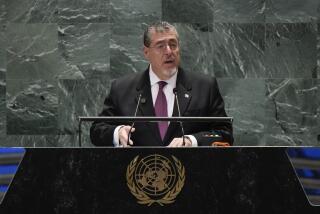U.N. Chief Faults Security in Somalia : Africa: Boutros-Ghali proposes fielding a force of 28,000 to take over from U.S.-led troops.
- Share via
UNITED NATIONS — Secretary General Boutros Boutros-Ghali, criticizing the American-led troops for falling short of imposing security in Somalia, proposed Thursday that the United Nations assemble a force of 28,000 soldiers to take their place, ideally by May 1.
After filing his proposals and a report on the Somalia operations with the Security Council, the secretary general, in an interview with The Times, observed: “I am saying that security has not been achieved. But anybody who just follows what happened during the last week can see that himself. . . .
“But I am not saying (the American operation) was a failure,” he went on. “Quite the contrary.”
The Americans, who led a force of 37,000 troops after the operation began in December, helped the United Nations at a crucial time in its attempt to relieve the starving millions in the embattled African country, Boutros-Ghali said. He congratulated the Americans and the troops of other nationalities for their initiative, skill and efficiency.
Still, the secretary general said these troops had not yet established a secure environment in Somalia and that the U.N. replacement forces would therefore have to have enough firepower and authority to impose security themselves.
In addition, they would have the authority, like the American troops, to go anywhere they want, whether or not the warlords of Somalia agree. This would involve the traditionally passive U.N. “blue helmets” in a new role of peace enforcement.
The report and comments of Boutros-Ghali reflect a longtime difference of opinion between him and American officials over the responsibilities of the American Marines dispatched to Somalia under U.N. authority by then-President George Bush.
Under the Security Council resolution authorizing the operations, the U.S.-led troops were charged with achieving a secure environment for the delivery of humanitarian aid. American officials insisted that this required them only to ensure that relief supplies reached the needy, while Boutros-Ghali insisted this required the troops to confiscate heavy weapons and make the country secure.
Noting that Lt. Gen. Robert B. Johnston, commander of Operation Restore Hope, had recently declared that “all areas are stable or relatively stable,” Boutros-Ghali painted a much different picture in his report. The U.S.-led forces, he said, “have continued to be the target of sniper fire and harassment, and, especially in recent weeks, major incidents of resumed fighting or rioting have been reported from Kismayu and Mogadishu.
“There is no doubt,” Boutros-Ghali went on, “that the presence and operations of (unified forces) have had, especially during the initial period of its deployment, a positive impact on the security situation in Somalia and on the effective delivery of humanitarian assistance. However . . . this improvement cannot yet be regarded as irreversible and conditions are still volatile. . . . Disarmament is far from complete.”
Boutros-Ghali, therefore, proposed a force of 20,000 combat troops and 8,000 logistic personnel under U.N. command to complete the job of imposing security. It is understood that the United States plans to leave 3,000 to 5,000 logistic troops under U.N. command.
More to Read
Sign up for Essential California
The most important California stories and recommendations in your inbox every morning.
You may occasionally receive promotional content from the Los Angeles Times.













